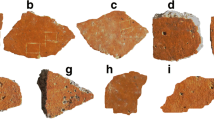Abstract
Most of the magnificent wall paintings from the ancient city of Pompeii are decorated with red and yellow colors coming from the ochre pigments used. The thermal impact of the pyroclastic flow from the eruption of Vesuvius, in AD 79, promoted the transformation of some yellow painted areas to red. In this work, original red ochre, original yellow ochre, and transformed yellow ochre (nowadays showing a red color) of wall paintings from Pompeian houses (House of Marcus Lucretius and House of Gilded Cupids) were analyzed by means of a handheld energy-dispersive X-ray fluorescence spectrometer to develop a fast method that allows chemical differentiation of the original red ochre and the transformed yellow ochre. Principal component analysis of the multivariate obtained data showed that arsenic is the tracer element to distinguish between both red colored ochres. Moreover, Pompeian raw red and yellow ochre pigments recovered from the burial were analyzed in the laboratory with use of a benchtop energy-dispersive X-ray fluorescence spectrometer to confirm the elemental composition and the conclusions drawn from the in situ analysis according to the yellow ochre pigment transformation in real Pompeian wall paintings.







Similar content being viewed by others
References
Varone A. Pompeii. I misteri di una città sepolta-Storia e segreti di un luogo in cui la vita si è fermata duemila anni fa. Newton Compton: Rome; 2005.
Madariaga JM, Maguregui M, Fdez-Ortiz De Vallejuelo S, Knuutinen U, Castro K, Martinez-Arkarazo I, et al. In situ analysis with portable Raman and ED-XRF spectrometers for the diagnosis of the formation of efflorescence on walls and wall paintings of the Insula IX 3 (Pompeii, Italy). J Raman Spectrosc. 2014;45:1059–67.
Maguregui M, Knuutinen U, Martínez-Arkarazo I, Castro K, Madariaga JM. Thermodynamic and spectroscopic speciation to explain the blackening process of hematite formed by atmospheric SO2 impact: the case of Marcus Lucretius House (Pompeii). Anal Chem. 2011;83:3319–26.
Maguregui M, Knuutinen U, Castro K, Madariaga JM. Raman spectroscopy as a tool to diagnose the impact and conservation state of Pompeian second and fourth style wall paintings exposed to diverse environments (House of Marcus Lucretius). J Raman Spectrosc. 2010;41:1400–9.
Higgings C. Pompeii shows its true colours. 2011. https://www.theguardian.com/science/2011/sep/22/pompeii-red-yellow. The Guardian. Accessed Jan 2017.
Foss P, Dobbins JJ. The world of Pompeii. New York: Routledge; 2009.
Eastaugh N, Walsh V, Chaplin C, Siddall R. Pigment compendium: a dictionary and optical microscopy of historical pigments. Woburn: Butterworth-Heinemann; 2008. p. 71–2.
Gurioli L, Houghton BF, Cashman KV, Cioni R. Complex changes in eruption dynamics during the 79 AD eruption of Vesuvius. Bull Volcanol. 2005;67:144–59.
British Museum. British Museum - eruption timeline. 2017. http://www.britishmuseum.org/whats_on/past_exhibitions/2013/pompeii_and_herculaneum/eruption_timeline.aspx. Accessed Jan 2017.
Popelka-Filcoff RS, Robertson JD, Glascock MD, Descantes C. Trace element characterization of ochre from geological sources. J Radioanal Nucl Chem. 2007;272:17–27.
Popelka-Filcoff RS. Applications of elemental analysis for archaeometric studies: analytical and statistical methods for understanding geochemical trends in ceramics, ochre and obsidian. Doctoral dissertation, University of Missouri–Columbia. 2006.
Jercher M, Pring A, Jones PG, Raven MD. Rietveld X-ray diffraction and X-ray fluorescence analysis of Australian aboriginal ochres. Archaeometry. 1998;40:383–401.
Morillas H, García-Galán J, Maguregui M, Marcaida I, García-Florentino C, Carrero JA, et al. Assessment of marine and urban-industrial environments influence on built heritage sandstone using X-ray fluorescence spectroscopy and complementary techniques. Spectrochim Acta B. 2016;123:76–88.
García-Florentino C, Maguregui M, Morillas H, Marcaida I, Madariaga JM. A fast in situ non-invasive approach to classify mortars from a construction of high historical value. Microchem J. 2017;133:104–13.
MATLAB and Statistics Toolbox Release 2010. Natick: The MathWorks.
Morillas H, Maguregui M, García-Florentino C, Carrero JA, Salcedo I, Madariaga JM. The cauliflower-like black crusts on sandstones: a natural passive sampler to evaluate the surrounding environmental pollution. Environ Res. 2016;147:218–32.
Marcaida I, Maguregui M, Morillas H, García-Florentino C, Knuutinen U, Carrero JA, et al. Multi-spectroscopic and isotopic ratio analysis to characterize the inorganic binder used on Pompeian pink and purple lake pigments. Anal Chem. 2016;88:6395–402.
Acknowledgements
The authors thank the Naples National Archaeological Museum for the permission given to extract samples of raw pigments contained in the original bowls. Moreover we gratefully thank the “Soprintendenza Pompei” for the permission given to analyze in situ the wall paintings in the houses studied. Iker Marcaida and Marco Veneranda are grateful to the Basque Government and the Ministry of Industry and Competitiveness (MINECO) respectively, which funded their predoctoral fellowships. This work was funded by the Ministry of Economy and Competitiveness (MINECO) and the European Regional Development Fund (FEDER) through the project DISILICA-1930 (reference BIA2014-59124-P).
Author information
Authors and Affiliations
Corresponding author
Ethics declarations
Conflict of interest
The authors declare that they have no conflict of interest.
Electronic supplementary material
Below is the link to the electronic supplementary material.
ESM 1
(PDF 116 kb)
Rights and permissions
About this article
Cite this article
Marcaida, I., Maguregui, M., Fdez-Ortiz de Vallejuelo, S. et al. In situ X-ray fluorescence-based method to differentiate among red ochre pigments and yellow ochre pigments thermally transformed to red pigments of wall paintings from Pompeii. Anal Bioanal Chem 409, 3853–3860 (2017). https://doi.org/10.1007/s00216-017-0329-3
Received:
Revised:
Accepted:
Published:
Issue Date:
DOI: https://doi.org/10.1007/s00216-017-0329-3




